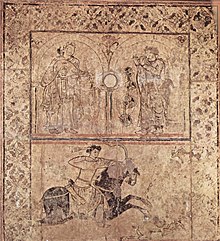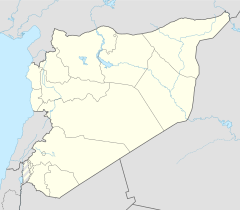Qasr al-Hayr al-Gharbi
| Qasr al-Hayr al-Gharbi قصر الحير الغربي | |
|---|---|
 Qasr al-Heer al-Gharbi facade | |
| General information | |
| Town or city | Homs Governorate |
| Country | Syria |
| Coordinates | 34°22′28″N 37°36′21″E / 34.374444°N 37.605833°E |
Qasr al-Hayr al-Gharbi (
Description

Qasr al-Hayr al-Gharbi is one of a number of Umayyad desert castles in the Syrian/Jordanian region. The site originally consisted of a palace complex, a bath house, industrial buildings for the production of olive oil, an irrigated garden and another building which scholars suggest may have been a caravanserai. Over the entrance is an inscription which declares that it was built by Hisham in the year 727, a claim that is borne out by the architectural style.[2]
It was used as an eye of the king during the Umayyad era, to control the movement of the desert tribes and to act as a barrier against marauding tribes, as well as serving a
The castle is quadrangular in outline with 70-metre (230 ft) sides. The central doorway to the castle is very attractive and has been moved to the
Little of the original castle remains; however, the reservoir to collect water from Harbaka dam, a bath and a khan are still visible. The gateway is preserved as a façade in the National Museum of Damascus.
Art found within the complex

Although the site of the complex features degrading architecture, several artistic works have been located, including a stucco wall and a fresco floor.
See also
References
- ^ "Discover Islamic Art - Virtual Museum". islamicart.museumwnf.org. Retrieved 2024-04-22.
- ^ Fowden, G., Qusayr 'Amra: Art and the Umayyad Elite in Late Antique Syria, University of California Press, 2004 p. 157
- ^ Petersen, A., Dictionary of Islamic Architecture, Routledge, 2002 , p. 238
- ^ Brend, B., Islamic Art, Harvard University Press, 1991, pp. 24–26
- ISBN 978-1-003-37404-6.
- ISBN 978-0-7546-5909-9.
- ^ a b "Lower half of a sculpturesque high relief - Discover Islamic Art - Virtual Museum". islamicart.museumwnf.org. Retrieved 2024-04-22.
- ^ ISBN 978-1-315-69141-1, retrieved 2024-04-22
External links
- "Qasr Al Hir". Syria Gate. Archived from the original on 2007-11-18.
- Genequand, Denis (2013). "Some Thoughts on Qasr al-Hayr al-Gharbi, its Dam, its Monastery and the Ghassanids". Levant. 38 (1): 63–84. ISSN 0075-8914.


